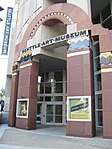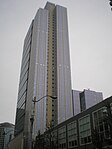The Diller Hotel
1890 establishments in Washington (state)Hotels established in 1890Hotels in Seattle

The Diller Hotel is a former hotel building in downtown Seattle, Washington. In the early 1900s, it was known as one of Seattle's few luxury hotels. This historic building is located at the corner of First Avenue and University Street, across from the Seattle Art Museum, and is one of the few remaining buildings left from the 1890s, a period of reconstruction and commercial development after the area was destroyed by the fire of 1889. The hotel was owned by Leonard Diller (1839–1901) and family and was designed by architect Louis L. Mendel. The building is now home to The Diller Room, a craft cocktail bar housed in the former hotel lobby.
Excerpt from the Wikipedia article The Diller Hotel (License: CC BY-SA 3.0, Authors, Images).The Diller Hotel
University Street, Seattle Belltown
Geographical coordinates (GPS) Address External links Nearby Places Show on map
Geographical coordinates (GPS)
| Latitude | Longitude |
|---|---|
| N 47.606944444444 ° | E -122.33777777778 ° |
Address
Diller Building
University Street
98161 Seattle, Belltown
Washington, United States
Open on Google Maps









